
The Assault Amphibious Vehicle (AAV)—official designation AAVP-7A1 —is a fully tracked amphibious landing vehicle manufactured by U.S. Combat Systems.

The Battle of Inchon, also spelled Battle of Incheon, was an amphibious invasion and a battle of the Korean War that resulted in a decisive victory and strategic reversal in favor of the United Nations Command (UN). The operation involved some 75,000 troops and 261 naval vessels and led to the recapture of the South Korean capital of Seoul two weeks later. The code name for the Inchon operation was Operation Chromite.

The Amphibious Vehicle, Tracked (LVT) is an amphibious warfare vehicle and amphibious landing craft, introduced by the United States Navy and United States Marine Corps. The United States Army, Canadian Army and British Army used several LVT models during World War II, and referred to those vehicles as "Landing Vehicle, Tracked."
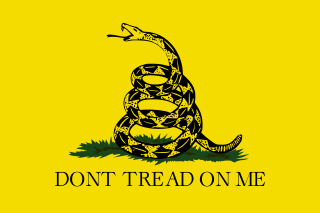
The Continental Marines were the amphibious infantry of the American Colonies during the American Revolutionary War. The Corps was formed by the Continental Congress on November 10, 1775 and was disbanded in 1783. Their mission was multi-purpose, but their most important duty was to serve as onboard security forces, protecting the captain of a ship and his officers. During naval engagements, in addition to manning the cannons along with the crew of the ship, Marine sharpshooters were stationed in the fighting tops of a ship's masts specifically to shoot the opponent's officers, naval gunners, and helmsmen.
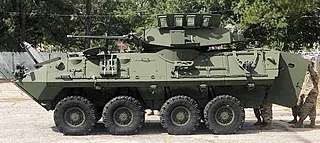
The LAV-25 is a member of the LAV II family. It is an eight-wheeled amphibious armored reconnaissance vehicle built by General Dynamics Land Systems and used by the United States Marine Corps and the United States Army.
In the United States Marine Corps, a Marine Air–Ground Task Force is the principal organization for all missions across the range of military operations. MAGTFs are a balanced air–ground, combined arms task organization of Marine Corps forces under a single commander that is structured to accomplish a specific mission. The MAGTF was formalized by the publishing of Marine Corps Order 3120.3 in December 1963, "The Marine Corps in the National Defense, MCDP 1-0". It stated:
A Marine air–ground task force with separate air ground headquarters is normally formed for combat operations and training exercises in which substantial combat forces of both Marine aviation and Marine ground units are included in the task organization of participating Marine forces.
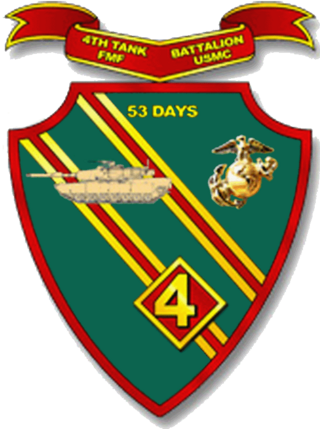
4th Tank Battalion was an armored battalion of the United States Marine Corps Reserve. Their primary weapon system was the M1A1 Abrams main battle tank and they were part of the 4th Marine Division and Marine Forces Reserve. The unit headquarters was at the Navy and Marine Corps Reserve Center San Diego, California, but other units in the battalion were located throughout the United States. Until the decision to divest the Marine Corps' armor capability, 4th Tank Battalion was the largest tank battalion in the US military with six lettered companies and an H&S Company.
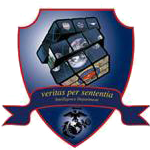
The Marine Corps Intelligence is the intelligence arm of the United States Marine Corps (USMC) and an element of the United States Intelligence Community. The Director of Intelligence supervises the Intelligence Department of HQMC and is responsible for policy, plans, programming, budgets, and staff supervision of Intelligence and supporting activities within the U.S. Marine Corps as well as supervising the Marine Corps Intelligence Activity (MCIA). The department supports the Commandant of the Marine Corps (CMC) in his role as a member of the Joint Chiefs of Staff (JCS), represents the service in Joint and Intelligence Community matters, and exercises supervision over the MCIA.

The United States Marine Corps is organized within the Department of the Navy, which is led by the Secretary of the Navy (SECNAV). The most senior Marine commissioned officer is the Commandant of the Marine Corps, responsible for organizing, recruiting, training, and equipping the Marine Corps so that it is ready for operation under the command of the unified combatant commanders. The Marine Corps is organized into four principal subdivisions: Headquarters Marine Corps, the Operating Forces, the Supporting Establishment, and the Marine Forces Reserve.
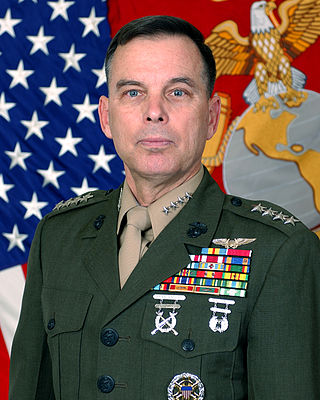
William L. "Spider" Nyland, a veteran of the Vietnam War, is a retired United States Marine Corps four-star General who served as the Assistant Commandant of the Marine Corps from 2002 to 2005. He retired from the Marine Corps in November 2005 after over 37 years of distinguished service.
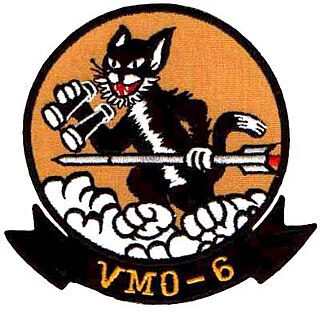
Marine Observation Squadron 6 (VMO-6) was an observation squadron of the United States Marine Corps which saw extensive action during the Battle of Okinawa in World War II and the Korean and Vietnam Wars. The squadron was the first Marine Corps helicopter squadron to participate in combat operations when it participated in the Battle of Pusan Perimeter in August 1950. The squadron was decommissioned on 1 January 1977.
The Marine Corps Gazette is a professional journal by and for members of the United States Marine Corps. Known as "The Professional Journal of U.S. Marines", the Gazette was founded in 1916 at Marine Corps Base Quantico by Colonel John A. Lejeune as the vehicle to launch the Marine Corps Association (MCA). The MCA continues to publish the Gazette alongside Leatherneck Magazine. The headquarters of the Gazette is in Quantico, Virginia.

The United States Marine Corps (USMC), also referred to as the United States Marines, is the maritime land force service branch of the United States Armed Forces responsible for conducting expeditionary and amphibious operations through combined arms, implementing its own infantry, artillery, aerial, and special operations forces. The U.S. Marine Corps is one of the eight uniformed services of the United States.
The Fleet Landing Exercises, or FLEX were amphibious landing exercises conducted by the United States Navy and United States Marine Corps between 1935 and 1941. The purpose of these exercises was to formulate a workable amphibious warfare doctrine. The development of the necessary craft and other equipment, and the proper tactical deployment of them were also results. Finally, the exercises demonstrated the usefulness of a standing body of Marines, the Fleet Marine Force, specially prepared for amphibious expeditions.

The 1st Armored Car Squadron was a unit of the United States Marine Corps which was intended to utilize armored cars in combat. The unit was formed in 1916 in Philadelphia under Marine Captain Andrew B. Drum, falling under the Headquarters of the then-new 1st Marine Regiment.
Andrew Boggs Drum was an officer in the United States Marine Corps. He was born in Winchester, Virginia, and moved to Washington, D.C., when he was nine. His father, Andrew B. Drum, Sr., was superintendent of Arlington National Cemetery from 1892 to 1906. He graduated from Western High School in Washington D.C. in 1903 and was commissioned a second lieutenant in the Marine Corps in 1905. Prior to joining the Marines, he had served in the National Guard of the District of Columbia.
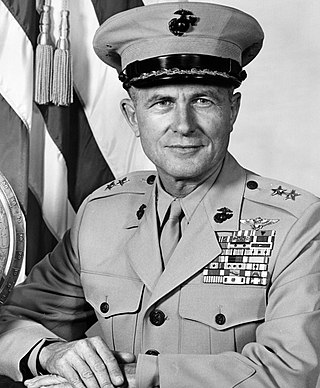
Robert Prescott Keller was a highly decorated Naval aviator in the United States Marine Corps with the rank of lieutenant general. He began his career as reserve pilot during World War II; he shot down one enemy aircraft and damaged two others during New Britain campaign. Keller distinguished himself again as pilot during Korean War and later reached general's rank during Vietnam War.
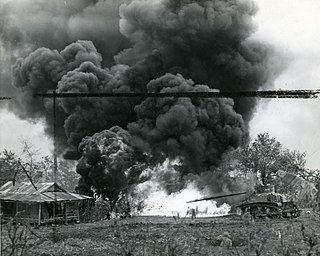
During WWII United States Naval Construction Battalions ("Seabees") modified/created all of the main armament flame throwing tanks that were used in the Pacific War: by USMC in the Battle of Saipan, Battle of Tinian, Battle of Iwo Jima, and by the U.S. Army in the Battle of Okinawa.

When WWII broke the United States had no mechanized flamethrowing capability. It is believed that an officer in the 754th U.S. Army tank battalion came up with the idea of mounting a flame thrower on a M3 Light tank on the island of New Caledonia. The Army used the idea on New Georgia and the Marines during the Battle of Bougainville. After which further development passed to the U.S. Army. Chemical Warfare Service at Schofield Barracks, Territory of Hawaii. There the Army reached out to the United States Naval Construction Force for assistance. The Seabees accepted the offer and converted or modified nearly 400 tanks for the Army. Those weapons set the standard for the U.S. through the Korean War. It was not until 1955 that a superior flame throwing tank replaced the Shermans the Seabees created.
















